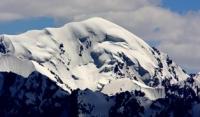You are here
Glaciers of Eastern Pamirs.

Tours to glaciers of Pamirs.
“The life we call happy lies at the top, and a steep road leads to it.”
Sights of Pamir glaciers.
The Eastern Pamir is an alpine desert surrounded by even higher mountain ranges rising to 5500 - 6800 meters above sea level. The center of the Eastern Pamirs is considered to be Lake Karakul, lying at an altitude of about 4000 m.
To the west and east of mountain lakes rise to 5200 - 5500 m, valleys are flat, slightly cut, small glaciers lie on the northern slopes. About the same type of relief in the southern part of the Eastern Pamirs. The Zaalaysky and Zulumart ridges are much higher (6000 - 6800 m), their slopes are very dissected, and they have large valley glaciers with a vertical glaciation range of up to 2000 m.
The average glaciation range of the entire East Pamir is small, about 600 m. The climate of the Eastern Pamirs is continental, dry. The large absolute altitude and great transparency of the atmosphere cause intense solar radiation and low air temperatures, and the closedness from the west by a barrier of high ridges leads to high air dryness and low rainfall.
The average annual air temperature in the area of Lake. Karakul - 3, - 7 °. In winter, frosts reach - 40 °. The summer is cool, the average July temperature is + 8.7 °, but frosts are possible in any of the summer months.
Precipitation is about 60 mm per year. On the slopes of the ranges, in the region of the food boundary and higher, there is more precipitation, which ensures the existence of modern glaciers. The bulk of precipitation falls in the spring and early summer in solid form.
In different parts of the Eastern Pamir and on the slopes of various exposures, snow accumulation above the nutrition limit ranges from 40-60 to 80-100 g / cm2 per year. The food border runs at an altitude of 5030 - 5200 m, an average of 5140 m.
The main types of ice formation are firn and ice. Despite the high intensity of solar radiation, ablation on the glaciers of the Eastern Pamirs is small, since a significant part of the radiation is spent not on melting, but on the evaporation of snow and ice.
This is associated with the formation of the so-called penitent forms of selective melting of snow and ice under conditions of direct solar radiation, a small amount of turbulent heat transfer, and a large heat transfer to evaporation and efficient radiation.
These forms are also characteristic of other glacial regions with dry and cold climate (volcanoes of South America, the highlands of the Himalayas, Antarctic “oases”). The speeds of glaciers in the Eastern Pamirs are small.
With the exception of large valley and dendritic glaciers, on which large masses of surface moraine are concentrated, glaciers of the Eastern Pamirs are distinguished by small moraines. They produce much less transport and exaration work compared with the glaciers of the West and Central
Pamir. The vibrations of their ends are also small. The division of the Pamirs according to the nature of the relief and climate into Western, Central and Eastern is widely used in geomorphology. However, the boundary between them is conditional, since in some areas the relief sections characteristic of the Eastern Pamirs alternate with the strongly dissected relief of the Western Pamir type, and vice versa. In addition, the border between these areas is drawn along the crests of ridges or cuts ridges into parts.
Therefore, adhering to the general description of the Pamir of this zoning, when characterizing glaciation, we grouped all the Pamir ridges into 4 regions:
1) Northern Pamir, which includes the entire Zaalaysky range.
2) The Central and Western Pamirs, including the ridge. Academies of Sciences with the ridges of Peter I, Darvaz, Vanch, Yazgulemsky and the North Tanymas ridge adjacent to it from the west.
3) South-Western Pamir - latitudinal ranges to the south of the Yazgulemsky range.
4) The Eastern Pamirs - the Zulumart, Sarykolsky, Muzkol, etc. ridges in the southeastern part of the Pamirs.
Authority:
"Glaciers." L.D. Dolgushin, G.B. Osipova. Series "Nature of the world." Moscow, the publishing house "Thought". 1989.
Photos by
Alexander Petrov.







